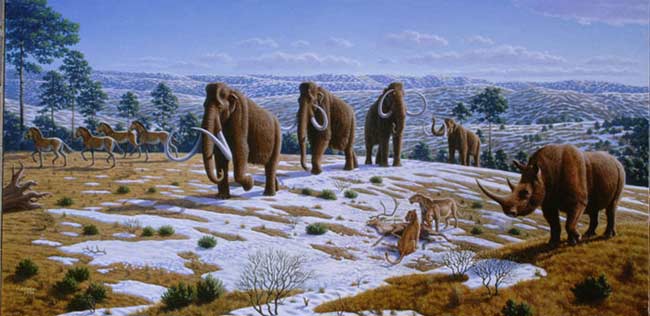Mammoths Were Alive More Recently Than Thought

Woolly mammoths and other large beasts in North America may not have gone extinct as long ago as previously thought.
The new view — that pockets of beasts survived to as recently as 7,600 years ago, rather than the previous end times mark of 12,000 years ago — is supported by DNA evidence found in a few pinches of dirt.
After plucking ancient DNA from frozen soil in central Alaska, researchers uncovered "genetic fossils" of both mammoths and horses locked in permafrost samples dated to between 10,500 and 7,600 years ago.
"We don't know how long it takes to pinch out a species," said Ross MacPhee, Curator of Mammalogy at the American Museum of Natural History. "Extinctions often seem dramatic and sudden in fossil records, but our study provides an idea of what an extinction event might look like in real time, with imperiled species surviving in smaller and smaller numbers until eventually disappearing completely."
At the end of the Pleistocene, the geological epoch roughly spanning 2.5 million years ago to 12,000 years ago, many of the world's megafauna — giant sloths, saber-toothed cats, dire wolves, stag-moose, and mammoths — vanished from the geological record. Some large species such as Equus caballus, the species from which the domestic horse derives, became extinct in North America but persisted in small populations elsewhere.
Scientists have blamed the extinctions on everything from human overhunting to a comet impact to the introduction of novel infectious diseases.
The swiftness of the extinctions, however, is not suggested directly by the fossils themselves but is inferred from radiocarbon dating of bones and teeth discovered on the surface or buried in the ground, the researchers involved in the new study point out. Current "macrofossil" evidence places the last-known mammoths and wild horses between 15,000 and 13,000 years ago.
Sign up for the Live Science daily newsletter now
Get the world’s most fascinating discoveries delivered straight to your inbox.
But hard remains of animals are rarely preserved, difficult to find, and laborious to accurately date because of physical degradation, the scientists said in a statement today.
So MacPhee and colleagues decided to tackle the problem by dating the creatures through dirt. Frozen sediments from the far north of Siberia and Canada can preserve small fragments of animal and plant DNA exceptionally well, even in the complete absence of any visible organic remains, such as bone or wood.
"In principle, you can take a pinch of dirt collected under favorable circumstances and uncover an amazing amount of forensic evidence regarding what species were on the landscape at the time," said co-researcher Eske Willerslev, director of the Centre for GeoGenetics at the University of Copenhagen.
The team collected soil cores from undisturbed Alaskan permafrost. Two independent methods (radiocarbon and optically stimulated luminescence) were used to date plant remains and individual mineral grains found in the same layers as the DNA.
"With these two techniques, we can be confident that the deposits from which the DNA was recovered haven't been contaminated since these lost giants last passed this way," said Richard Roberts of the University of Wollongong in Australia. "It's a genetic graveyard, frozen in time."
The core samples revealed the local Alaskan fauna at the end of the last Ice Age. The oldest sediments, dated to about 11,000 years ago, contain remnant DNA of Arctic hare, bison, and moose; all three animals were also found in higher, more recent layers, as would be expected. But one core, deposited between 10,500 and 7,600 years ago, confirmed the presence of both mammoth and horse DNA.
The team also developed a statistical model to show that mammoth and horse populations would have dwindled to a few hundred individuals by 8,000 years ago.
"At this point, mammoths and horses were barely holding on. We may actually be working with the DNA of some of the last members of these species in North America," said team member Duane Froese of the University of Alberta in Canada.
The findings are detailed in the Proceedings of the National Academy of Sciences.











